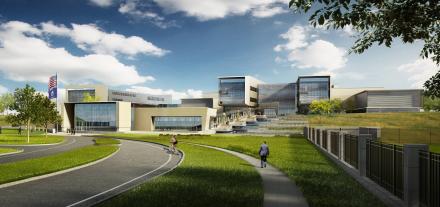Animal Disease Research Gets High-Tech New Home

The National Bio and Agro-Defense Facility in Manhattan, Kansas. Facility rendition courtesy of NBAF Design Partnership
The National Bio and Agro-Defense Facility (NBAF), in Manhattan, KS, is a world-class science facility that will expand USDA’s large-animal agricultural research, training, and diagnostics mission.
According to the USDA’s Economic Research Service, agriculture, food, and food processing contribute more than $1.05 trillion to the U.S. economy’s annual gross domestic product. Also, according to the World Health Organization, more than 70 percent of emerging diseases are zoonotic, meaning they can be transmitted from animals to humans. Yet the United States does not have current capacity for studying these diseases in large livestock at a biosafety level 4, or BSL-4, laboratory — the highest level of laboratory safety.
To defend agriculture and food systems against terrorist attacks, major disasters, and other emergencies, President George W. Bush issued Homeland Security Presidential Directive 9 in 2004, which included establishing an agriculture biocontainment laboratory to address these threats.
“Once NBAF is complete, we will no longer be dependent on other countries to provide research space at the highest level of containment to study livestock diseases," said Alfonso Clavijo, NBAF director. “These diseases have the potential to cause high livestock mortality, devastating economic impacts, and public health implications.”
The U.S Department of Homeland Security (DHS) is building the facility north of the Kansas State University campus with a $1.25 billion budget from federal, state, and city appropriations. DHS will transfer operations to USDA once it is complete in 2021.
“NBAF will be a critical component of a key USDA priority — the development of animal vaccines and other countermeasures for the detection of diseases that threaten livestock, other animals, and food from our nation’s farms and fields,” Clavijo said.
Currently, USDA’s Agricultural Research Service and Animal and Plant Health Inspection Service conduct transboundary animal disease research, training, and diagnostics at the more than 60-year-old Plum Island Animal Disease Center (PIADC) in New York. NBAF will replace PIADC by continuing and expanding on its mission. The new facility will add BSL-4 zoonotic research capabilities, double the number of science programs, and speed up the development of vaccines and countermeasures through a Biologics Development Module.
“Transboundary, emerging, and zoonotic animal diseases threaten the nation’s food supply, agriculture economy, and public health,” said Ken Burton, NBAF coordinator. “Currently, only four other facilities in the world are capable of doing research at the highest level of containment with large livestock. NBAF will be the newest and largest.”
Situated on 48 acres with more than 700,000 square feet of facility space, NBAF includes 574,000 square feet of biocontainment and lab space to house large livestock. The campus is self-contained with a utility plant and wastewater-treatment plant. It has multiple backups and reinforced safety features in the event of a natural disaster, and it will operate 24/7 with about 400 team members once fully operational — expected in 2023.
As of Nov. 1, USDA has hired about half of NBAF’s expected workforce. To learn more about NBAF, its capabilities, mission, and job opportunities, visit www.usda.gov/nbaf or its Twitter and LinkedIn channels for regular updates.—By Stephanie Jacques, NBAF Office of Communications.

